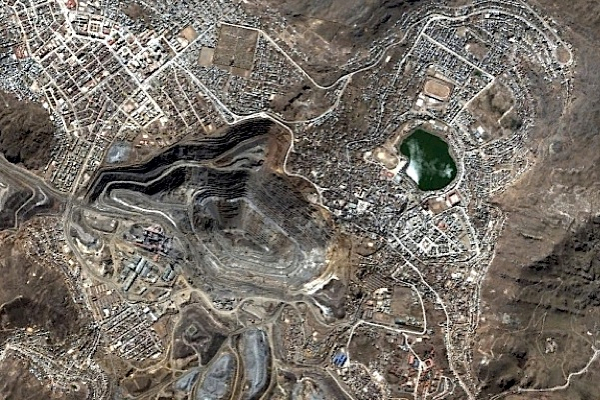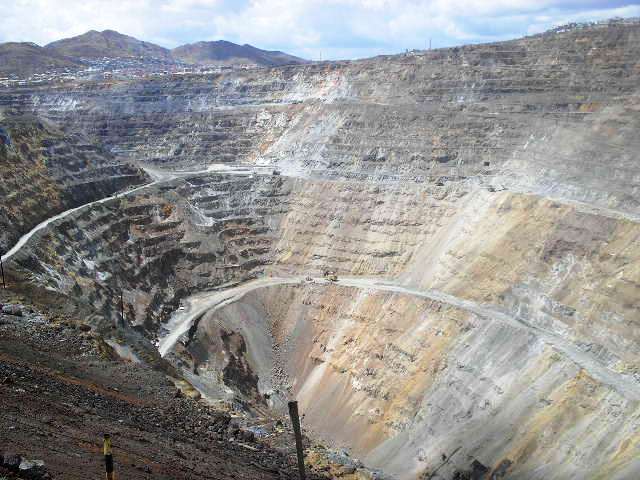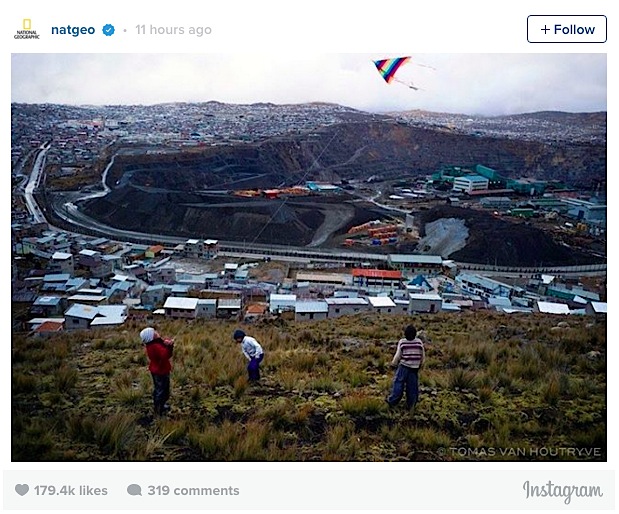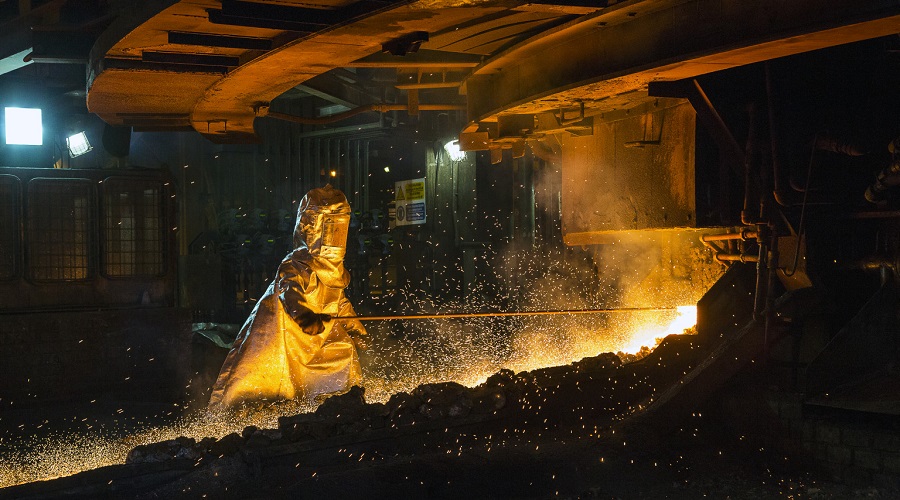Giant mine pit ‘swallowing’ 400-year-old Peruvian town

Mine pit. Aerial | Wikimedia Commons.
The Peruvian city of Cerro de Pasco, perched high up in the Andes, is about to sink into the deeps of a half-century-old, open-pit zinc and lead mine that has been belching streamers of dust and polluting its surroundings for years.
The locals, National Geographic reports, were submitted to a series of health tests in 1996 when the effects of contamination became more prominent. In 2007, the U.S. Centers of Disease Control and Prevention (CDC) joined the investigation only to verify the fact that more than half the children tested had high lead levels in their blood stream. This drove authorities to declare a “state of environmental emergency” in Cerro de Pasco in May 2012.

Via @NatGeo.
Very little has changed since. According to the article, locals keep dealing with lead poisoning and its consequences, including lower IQ levels, seizures, organ dysfunction, and even premature death.
Residents have made attempts to reach out to the central government, asking for a permanent solution, especially after 2,070 children were diagnosed with lead levels that implied twice the danger. The authorities’ promised to build a new hospital, however, has yet to become a reality.

Side view | Wikimedia Commons.
Meanwhile, the company that operates the vast mine, Volcan Compañía Minera, continues to expand the pit in the middle of the city, said to be as deep as the Empire State Building is tall.
Half-century mining history
The Spanish found silver in the caverns of Cerro de Pasco about 500 years ago, and through the 20th century its mines enriched many — including prominent Americans. The caverns were opened in 1956 and today the central Peruvian Andes region is still home to 14 mining companies operating at high production levels.
But the wealth extracted from Pasco’s land is, unfortunately, not shared among its people. The latest statistics available show that between 2013 and 2014, Cerro de Pasco was — in fact — the region that saw the highest rise in poverty in the whole country.
In 2008, Peru’s Congress passed Law No. 29293, calling for the resettlement of the entire population of Cerro de Pasco, a city of 70,000. But the government failed to come up with a process to accomplish that, so the law has largely been ignored.

Via @NatGeo.
A Volcan’s spokesman told National Geographic that moving the town was not the company’s responsibility. “It is an issue that concerns the national government, in coordination with the regional government and the local government of the city.”
In October, authorities met once again with community members who marched to Peru’s capital Lima. One of the key points agreed upon was that the Ministry of Health would guarantee care for all those with high levels of lead in their blood.
The government, local media reported (in Spanish) also agreed to build a clinic for heavy metals detoxification and a modern toxicology lab.
{{ commodity.name }}
{{ post.title }}
{{ post.date }}

3 Comments
Michel Robert
The settlement of Cerro de Pasco came into being in 1578 to lodge the Amerindian slaves and Spanish bosses/owners of the silver deposits at the site. For 4 centuries this was done mostly by underground mining and small surface trenches, under difficult if not terrible conditions for the workers. But likely no health effect on the rest of the population aside from putting food on the table. The big pit that exist now-a-day is post world war two thing, done by an American Company called Cerro de Pasco, And this is the main source of pollution according to some although I doubt it is the only source, technically.
The Peruvian military Junta that took control of Peru in the early 1970’s kicked out the company and took over the money being generated but did not do anything for the people. As years went by, the government through its own companies (Centromin and MineroPeru) kept on operating and increasing capacity.
In the 2000’s the Health disaster was finally seen, felt, recognized, but not much was done, let alone a common sense solution.
How about just moving the people away to a healthy area and rebuild the whole antique district if you want to, but remember that this antique district is a relic of the time when slavery, racism and sectarian culture dominated. Is it worth letting the 10 next next generations of kids be sick just to maintain that?
Michel Robert
Matthew Brook
This place cant be as bad as La Oroya. If your ever asked to go there just say no.
José Antonio Ardito Vega
First was the mine. The mine is the only economic activity at 4,400 msnm (13,000 fasl). There are neither trees nor enough oxygen. Like Potosi the human settlements came after finding ore there. Without mine there is no reason to have a city there.